2018 NISSAN NV PASSENGER VAN child restraint
[x] Cancel search: child restraintPage 73 of 426
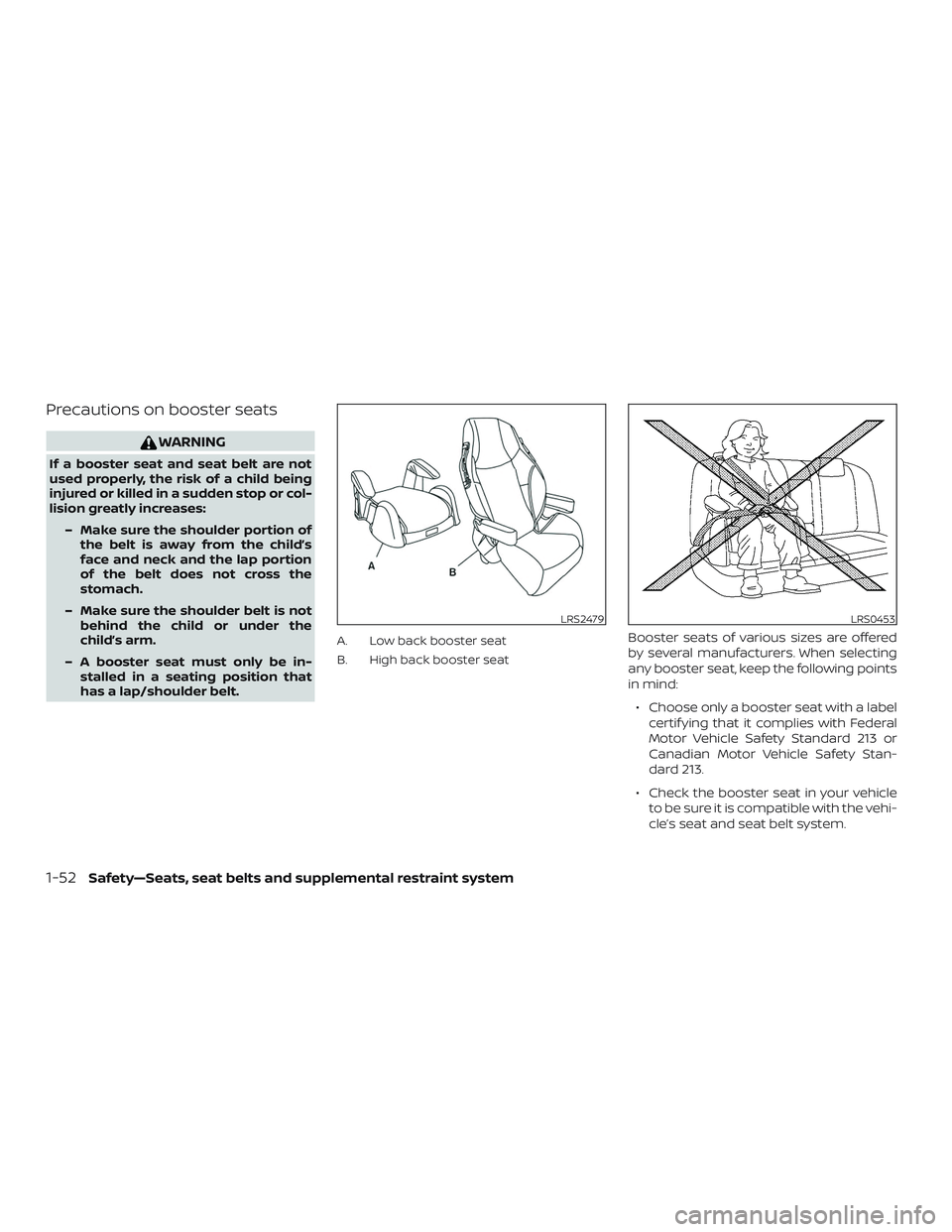
Precautions on booster seats
WARNING
If a booster seat and seat belt are not
used properly, the risk of a child being
injured or killed in a sudden stop or col-
lision greatly increases:– Make sure the shoulder portion ofthe belt is away from the child’s
face and neck and the lap portion
of the belt does not cross the
stomach.
– Make sure the shoulder belt is not behind the child or under the
child’s arm.
– A booster seat must only be in- stalled in a seating position that
has a lap/shoulder belt.
A. Low back booster seat
B. High back booster seatBooster seats of various sizes are offered
by several manufacturers. When selecting
any booster seat, keep the following points
in mind:
∙ Choose only a booster seat with a label certif ying that it complies with Federal
Motor Vehicle Safety Standard 213 or
Canadian Motor Vehicle Safety Stan-
dard 213.
∙ Check the booster seat in your vehicle to be sure it is compatible with the vehi-
cle’s seat and seat belt system.
LRS2479LRS0453
1-52Safety—Seats, seat belts and supplemental restraint system
Page 74 of 426
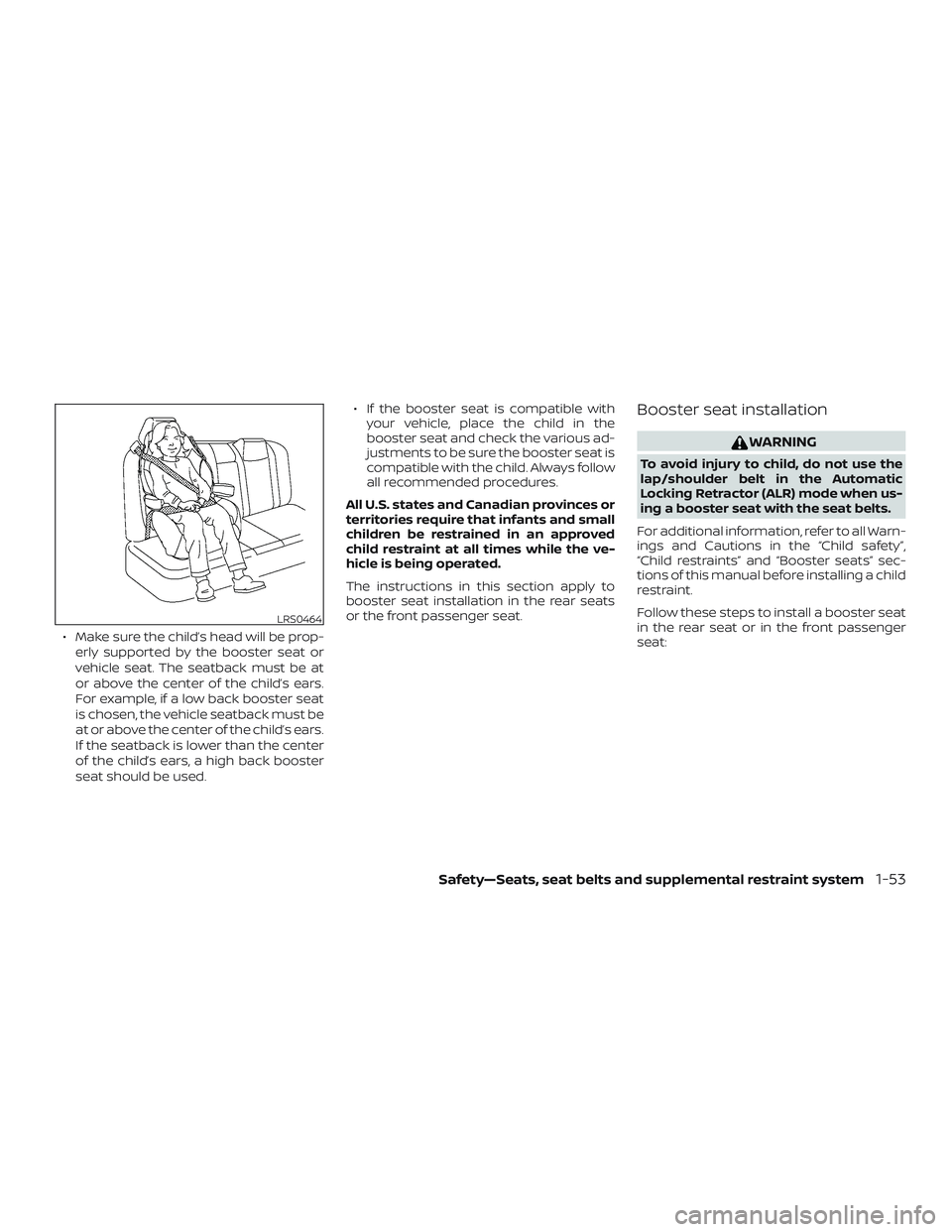
∙ Make sure the child’s head will be prop-erly supported by the booster seat or
vehicle seat. The seatback must be at
or above the center of the child’s ears.
For example, if a low back booster seat
is chosen, the vehicle seatback must be
at or above the center of the child’s ears.
If the seatback is lower than the center
of the child’s ears, a high back booster
seat should be used. ∙ If the booster seat is compatible with
your vehicle, place the child in the
booster seat and check the various ad-
justments to be sure the booster seat is
compatible with the child. Always follow
all recommended procedures.
All U.S. states and Canadian provinces or
territories require that infants and small
children be restrained in an approved
child restraint at all times while the ve-
hicle is being operated.
The instructions in this section apply to
booster seat installation in the rear seats
or the front passenger seat.
Booster seat installation
WARNING
To avoid injury to child, do not use the
lap/shoulder belt in the Automatic
Locking Retractor (ALR) mode when us-
ing a booster seat with the seat belts.
For additional information, refer to all Warn-
ings and Cautions in the “Child safety”,
“Child restraints” and “Booster seats” sec-
tions of this manual before installing a child
restraint.
Follow these steps to install a booster seat
in the rear seat or in the front passenger
seat:
LRS0464
Safety—Seats, seat belts and supplemental restraint system1-53
Page 75 of 426
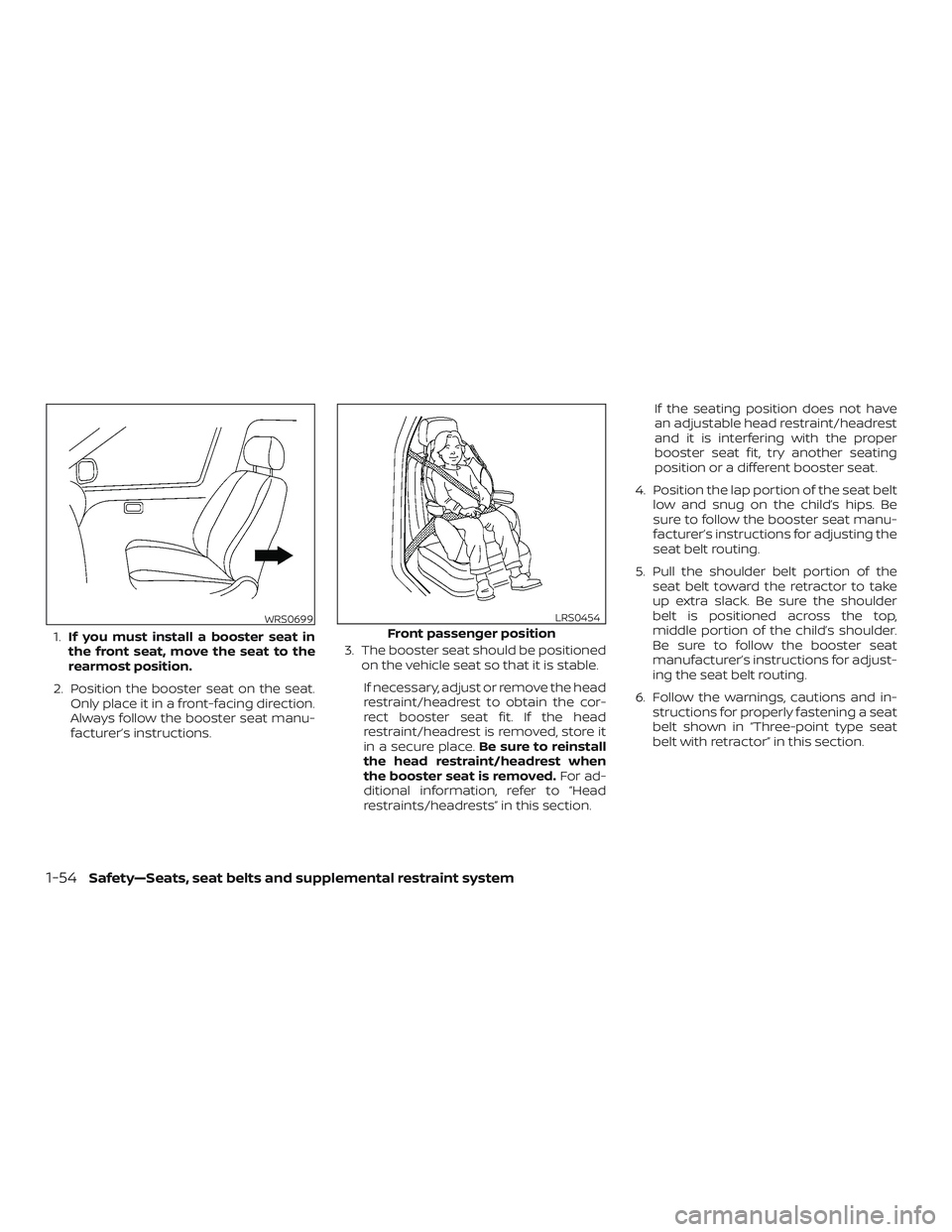
1.If you must install a booster seat in
the front seat, move the seat to the
rearmost position.
2. Position the booster seat on the seat. Only place it in a front-facing direction.
Always follow the booster seat manu-
facturer’s instructions. 3. The booster seat should be positioned
on the vehicle seat so that it is stable.
If necessary, adjust or remove the head
restraint/headrest to obtain the cor-
rect booster seat fit. If the head
restraint/headrest is removed, store it
in a secure place. Be sure to reinstall
the head restraint/headrest when
the booster seat is removed. For ad-
ditional information, refer to “Head
restraints/headrests” in this section. If the seating position does not have
an adjustable head restraint/headrest
and it is interfering with the proper
booster seat fit, try another seating
position or a different booster seat.
4. Position the lap portion of the seat belt low and snug on the child’s hips. Be
sure to follow the booster seat manu-
facturer’s instructions for adjusting the
seat belt routing.
5. Pull the shoulder belt portion of the seat belt toward the retractor to take
up extra slack. Be sure the shoulder
belt is positioned across the top,
middle portion of the child’s shoulder.
Be sure to follow the booster seat
manufacturer’s instructions for adjust-
ing the seat belt routing.
6. Follow the warnings, cautions and in- structions for properly fastening a seat
belt shown in “Three-point type seat
belt with retractor” in this section.
WRS0699Front passenger position
LRS0454
1-54Safety—Seats, seat belts and supplemental restraint system
Page 78 of 426
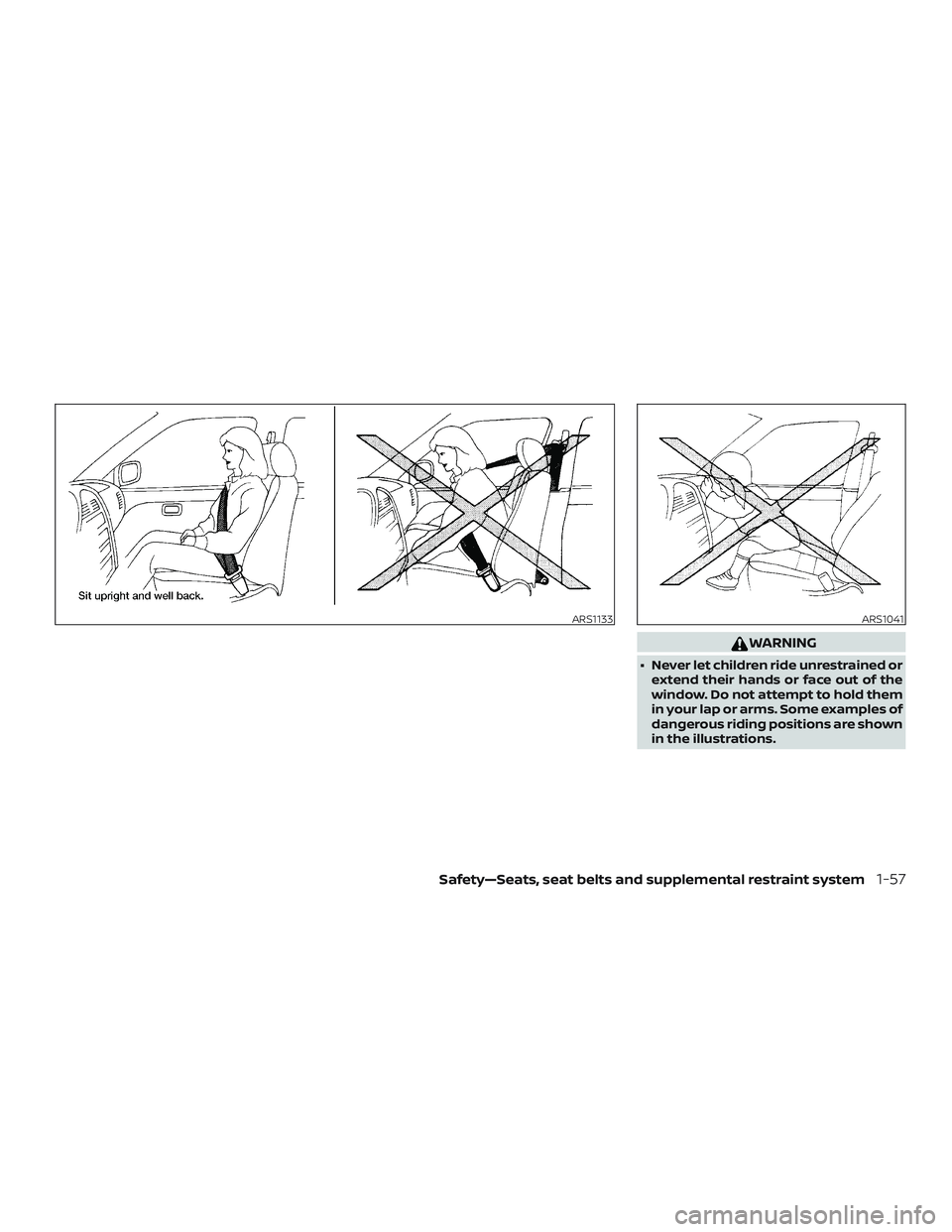
WARNING
∙ Never let children ride unrestrained orextend their hands or face out of the
window. Do not attempt to hold them
in your lap or arms. Some examples of
dangerous riding positions are shown
in the illustrations.
ARS1133ARS1041
Safety—Seats, seat belts and supplemental restraint system1-57
Page 80 of 426
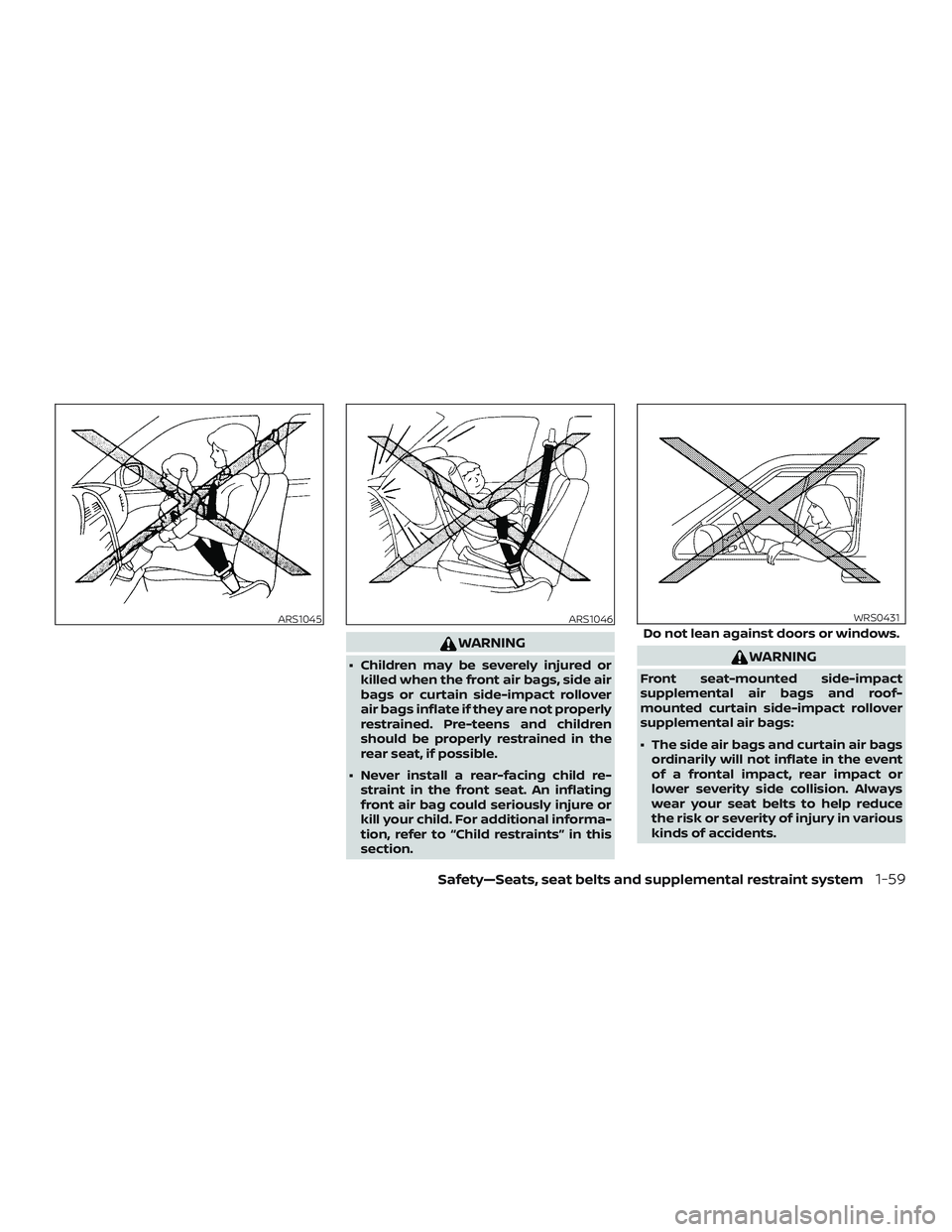
WARNING
∙ Children may be severely injured orkilled when the front air bags, side air
bags or curtain side-impact rollover
air bags inflate if they are not properly
restrained. Pre-teens and children
should be properly restrained in the
rear seat, if possible.
∙ Never install a rear-facing child re- straint in the front seat. An inflating
front air bag could seriously injure or
kill your child. For additional informa-
tion, refer to “Child restraints” in this
section.WARNING
Front seat-mounted side-impact
supplemental air bags and roof-
mounted curtain side-impact rollover
supplemental air bags:
∙ The side air bags and curtain air bagsordinarily will not inflate in the event
of a frontal impact, rear impact or
lower severity side collision. Always
wear your seat belts to help reduce
the risk or severity of injury in various
kinds of accidents.
ARS1045ARS1046Do not lean against doors or windows.
WRS0431
Safety—Seats, seat belts and supplemental restraint system1-59
Page 87 of 426
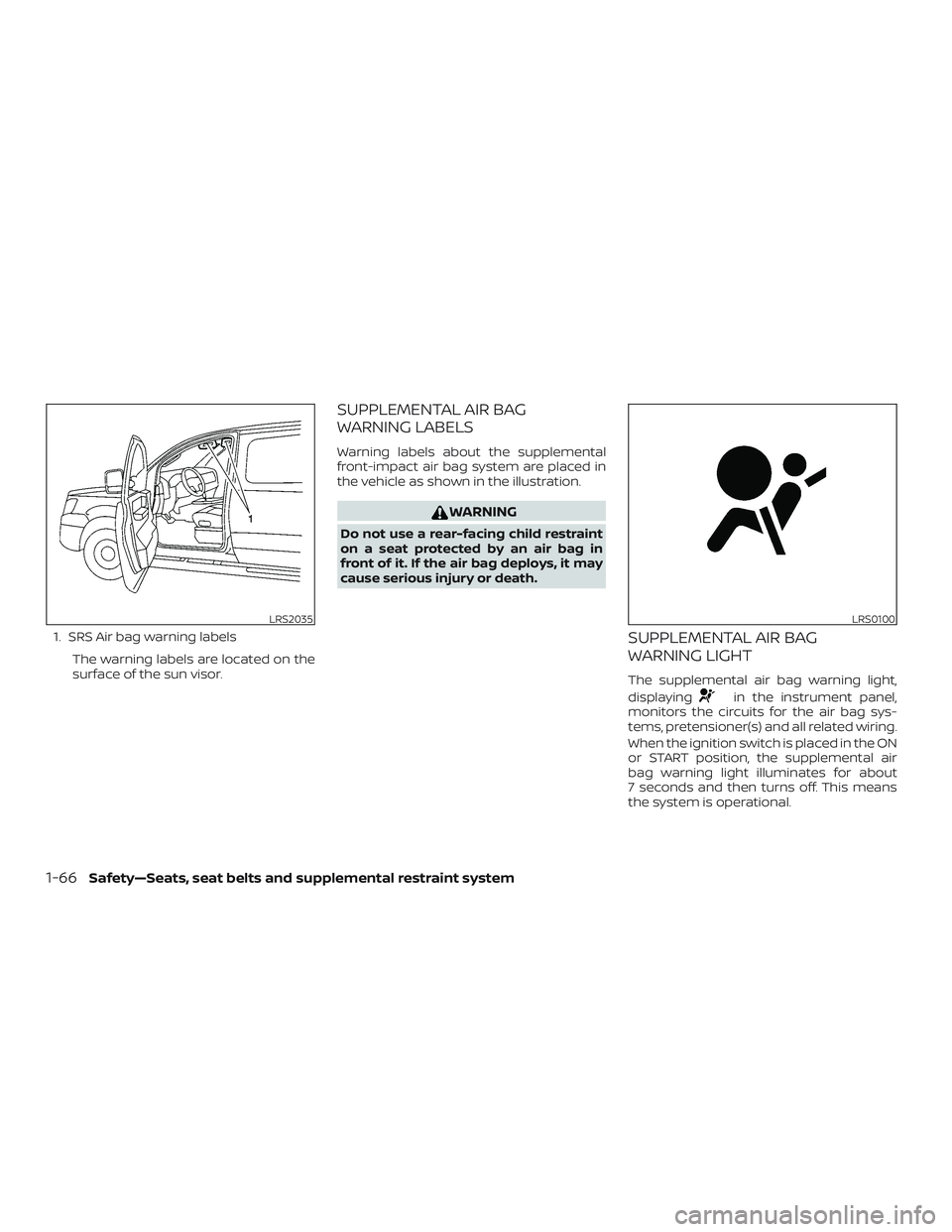
1. SRS Air bag warning labelsThe warning labels are located on the
surface of the sun visor.
SUPPLEMENTAL AIR BAG
WARNING LABELS
Warning labels about the supplemental
front-impact air bag system are placed in
the vehicle as shown in the illustration.
WARNING
Do not use a rear-facing child restraint
on a seat protected by an air bag in
front of it. If the air bag deploys, it may
cause serious injury or death.
SUPPLEMENTAL AIR BAG
WARNING LIGHT
The supplemental air bag warning light,
displaying
in the instrument panel,
monitors the circuits for the air bag sys-
tems, pretensioner(s) and all related wiring.
When the ignition switch is placed in the ON
or START position, the supplemental air
bag warning light illuminates for about
7 seconds and then turns off. This means
the system is operational.
LRS2035LRS0100
1-66Safety—Seats, seat belts and supplemental restraint system
Page 419 of 426
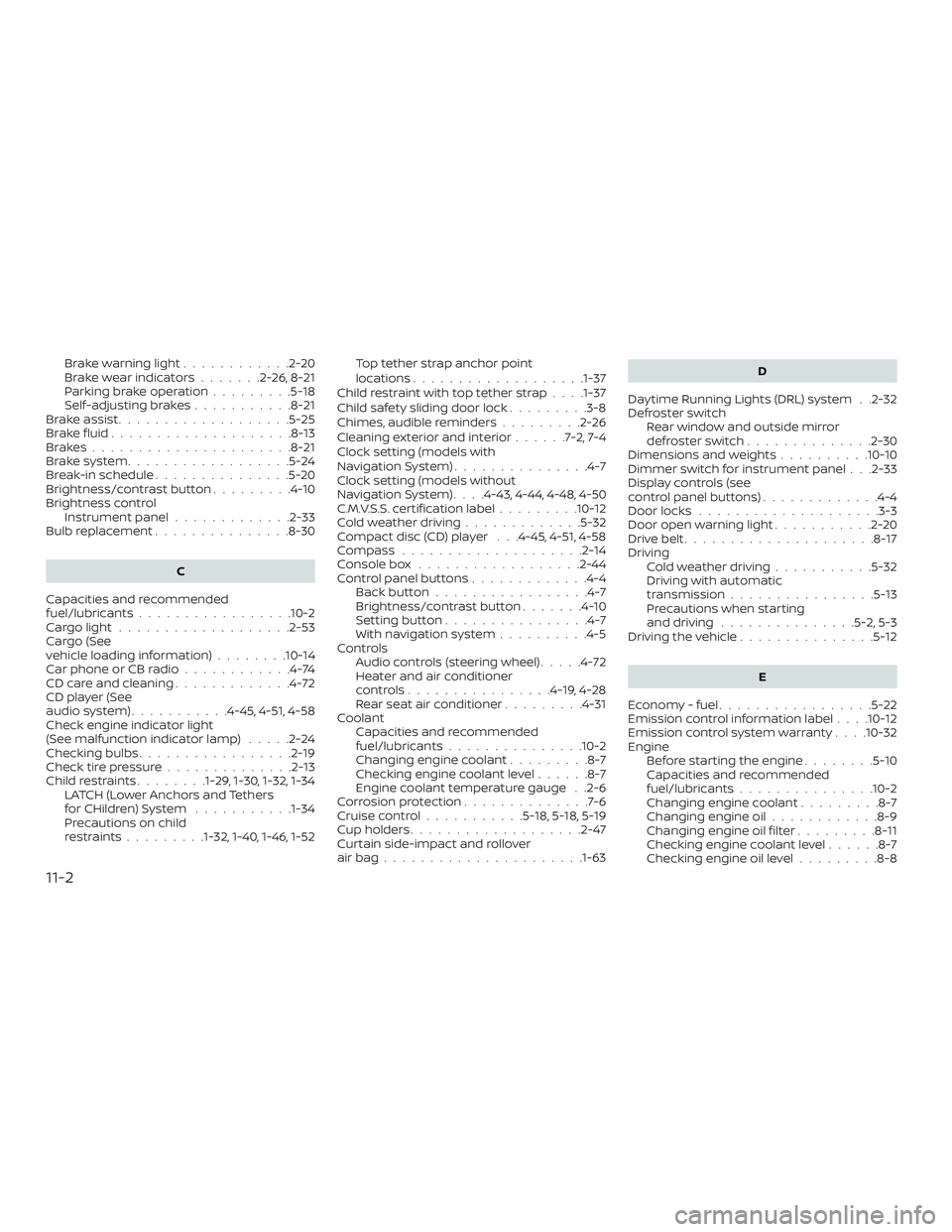
Brakewarninglight............2-20
Brakewearindicators.......2-26,8-21
Parking brake operation.........5-18
Self-adjustingbrakes...........8-21
Brake assist ...................5-25
Brakefluid....................8-13
Brakes......................8-21
Brake system ..................5-24
Break-in schedule ...............5-20
Brightness/contrast button .........4-10
Brightness control Instrument panel .............2-33
Bulb replacement ...............8-30
C
Capacities and recommended
fuel/lubricants.................10-2
Cargolight...................2-53
Cargo (See
vehicle loading information) ........10-14
Car phone or CB radio ............4-74
CDcareandcleaning.............4-72
CD player (See
audio system) ...........4-45,4-51,4-58
Check engine indicator light
(See malfunction indicator lamp) .....2-24
Checking bulbs .................2-19
Check tire pressure ..............2-13
Childrestraints........1-29, 1-30, 1-32, 1-34 LATCH (Lower Anchors and Tethers
forCHildren)System ...........1-34
Precautions on child
restraints.........1-32, 1-40, 1-46, 1-52 Top tether strap anchor point
locations..................
.1-37
Child restraint with top tether strap . . . .1-37
Child safety sliding door lock .........3-8
Chimes, audible reminders .........2-26
Cleaningexteriorandinterior......7-2,7-4
Clock setting (models with
NavigationSystem)...............4-7
Clock setting (models without
NavigationSystem)....4-43,4-44,4-48,4-50
C.M.V.S.S. certification label .........10-12
Cold weather driving .............5-32
Compact disc (CD) player . . .4-45, 4-51, 4-58
Compass ....................2-14
Console box ..................2-44
Control panel buttons .............4-4
Back button .................4-7
Brightness/contrast button .......4-10
Settingbutton................4-7
Withnavigationsystem..........4-5
Controls Audio controls (steering wheel) .....4-72
Heater and air conditioner
controls................4-19,4-28
Rear seat air conditioner .........4-31
Coolant Capacities and recommended
fuel/lubricants...............10-2
Changing engine coolant .........8-7
Checking engine coolant level ......8-7
Engine coolant temperature gauge . .2-6
Corrosionprotection..............7-6
Cruisecontrol...........5-18,5-18,5-19
Cupholders...................2-47
Curtain side-impact and rollover
airbag..................... .1-63D
Daytime Running Lights (DRL) system . .2-32
Defroster switch Rear window and outside mirror
defrosterswitch..............2-30
Dimensions and weights ..........10-10
Dimmer switch for instrument panel . . .2-33
Display controls (see
control panel buttons) .............4-4
Door locks ....................3-3
Door open warning light ...........2-20
Drivebelt.....................8-17
Driving Coldweatherdriving...........5-32
Driving with automatic
transmission ................5-13
Precautions when starting
anddriving.............. .5-2, 5-3
Driving the vehicle ...............5-12
E
Economy - fuel .................5-22
Emission control information label . . . .10-12
Emission control system warranty . . . .10-32
Engine Before starting the engine ........5-10
C
apacities and recommended
fuel/lubricants...............10-2
Changing engine coolant .........8-7
Changing engine oil ............8-9
Changing engine oil filter .........8-11
Checking engine coolant level ......8-7
Checking engine oil level .........8-8
11-2
Page 421 of 426
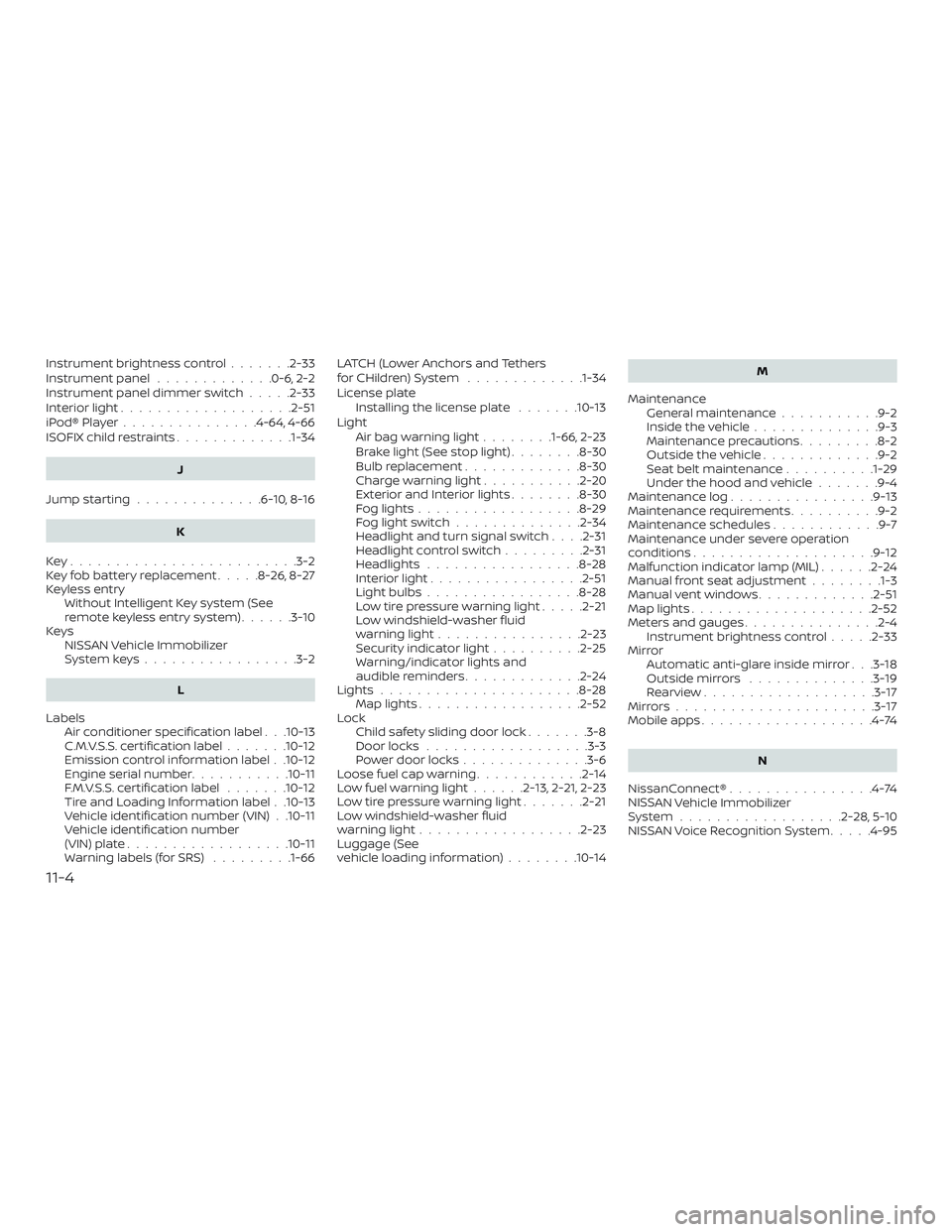
Instrument brightness control.......2-33
Instrument panel .............0-6,2-2
Instrument panel dimmer switch .....2-33
Interiorlight...................2-51
iPod®Player...............4-64,4-66
ISOFIX child restraints .............1-34
J
Jumpstarting..............6-10,8-16
K
Key.........................3-2
Key fob battery replacement .....8-26,8-27
Keyless entry Without Intelligent Key system (See
remote keyless entry system) ......3-10
Keys NISSAN Vehicle Immobilizer
Systemkeys.................3-2
L
Labels Air conditioner specification label . . .10-13
C.M.V.S.S. certification label .......10-12
Emission control information label . .10-12
Engine serial number ...........10-11
F.M.V.S.S. certification label .......10-12
Tire and Loading Information label . .10-13
Vehicle identification number (VIN) . .10-11
Vehicle identification number
(VIN)plate..................10-11
Warning labels (for SRS) .........1-66LATCH (Lower Anchors and Tethers
forCHildren)System ............
.1-34
License plate Installing the license plate .......10-13
Light Airbagwarninglight........1-66, 2-23
Brakelight(Seestoplight)........8-30
Bulb replacement .............8-30
Charge warning light ...........2-20
ExteriorandInteriorlights........8-30
Foglights..................8-29
Foglightswitch..............2-34
Headlight and turn signal switch ....2-31
Headlightcontrolswitch.........2-31
Headlights.................8-28
Interiorlight.................2-51
Lightbulbs.................8-28
Low tire pressure warning light .....2-21
Low windshield-washer fluid
warninglight................2-23
Security indicator light ..........2-25
Warning/indicator lights and
audible reminders .............2-24
Lights......................8-28 Maplights..................2-52
Lock Child safety sliding door lock .......3-8
Door locks ..................3-3
Power door locks ..............3-6
Loose fuel cap warning ............2-14
Lowfuelwarninglight......2-13,2-21,2-23
Low tire pressure warning light .......2-21
Low windshield-washer fluid
warninglight..................2-23
Luggage (See
vehicle loading information) ........10-14 M
Maintenance General maintenance ...........9-2
Insidethevehicle..............9-3
Maintenance precautions .........8-2
Outsidethevehicle.............9-2
Seat belt maintenance ..........1-29
Under the hood and vehicle .......9-4
Maintenance log ................9-13
Maintenance requirements ..........9-2
Maintenance schedules ............9-7
Maintenance under severe operation
conditions....................9-12
Malfunctionindicatorlamp(MIL)......2-24
Manual front seat adjustment ........1-3
Manual vent windows .............2-51
Maplights....................2-52
Meters and gauges ...............2-4
Instrument brightness control .....2-33
Mirror Automatic anti-glare inside mirror . . .3-18
Outsidemirrors ..............3-19
Rearview...................3-17
Mirrors......................3-17
Mobile apps ...................4-74
N
NissanConnect® ................4-74
NISS
AN Vehicle Immobilizer
System..................2-28,5-10
NISSAN Voice Recognition System .....4-95
11-4